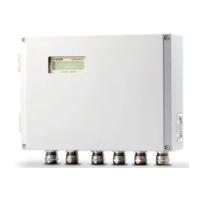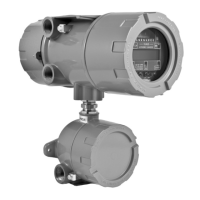16 Advanced functions
FLUXUS G809 16.11 Activation of a binary output as alarm output
143
UMFLUXUS_G809V2-2EN, 2020-06-25
16.11 Activation of a binary output as alarm output
• Select the channel for which the output is to be activated in the program branch Output Options.
• Press ENTER.
This display will not be indicated if the transmitter has only one measuring channel.
• Press ENTER until Alarm Output is displayed. Select yes to activate the alarm output.
• Press ENTER.
A max. of 3 independently operating alarm outputs R1, R2, R3 can be configured per channel. The alarm outputs can be
used to output information on the current measurement or to start and stop pumps, motors, etc.
16.11.1 Alarm properties
The switching condition, the holding behavior and the switching function of an alarm output can be defined.
The following 3 scroll lists are displayed:
• func: switching condition
• typ: holding behavior
• mode: switching function
Press key to select a scroll list in the upper line. Press key to select a list item in the lower line.
• Press ENTER to store the settings.
Notice!
The menu item Alarm Output will only be displayed in the program branch Output Options if a binary output
has been installed, see section 13.1.
Output Options\for Channel A
Tab. 16.2: Alarm properties
alarm property setting description
func
(switching condition)
MAX The alarm will switch if the measured value exceeds the upper limit.
MIN The alarm will switch if the measured value falls below the lower limit.
+→- -→+ The alarm will switch if the flow direction changes (sign change of measured value).
QUANT. The alarm will switch if totalizing is activated and the totalizer reaches the limit.
ERROR The alarm will switch if a measurement is not possible.
OFF The alarm is switched off.
typ
(holding behavior)
NON-HOLD If the switching condition is no longer true, the alarm will return to the idle state after
approx. 1 s.
HOLD The alarm remains activated even if the switching condition is no longer true.
mode
(switching function)
NO Cont. The alarm is energized if the switching condition is true and de-energized if idle.
NC Cont. The alarm is de-energized if the switching condition is true and energized if idle.
Notice!
If no measurement is made, all alarms will be de-energized, independently of the programmed switching function.
R1=FUNC<typ mode
Function: MAX

